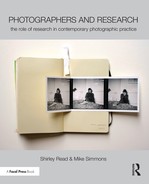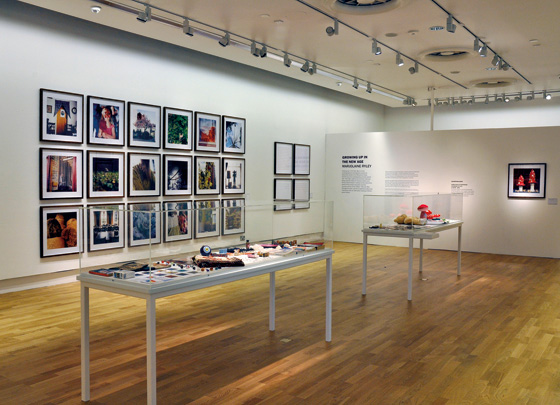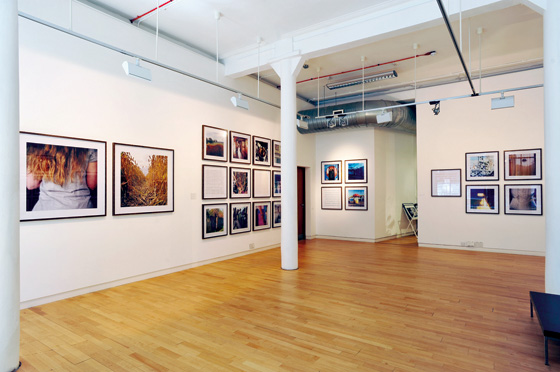Camilla Brown: In the Public Domain—A Curator’s Perspective
The term curator is currently used for a variety of different roles and approaches, so for clarity it seems worthwhile setting it in some form of context. My background has been working as a curator in the UK public gallery sector, with 10 years spent in a curatorial role at The Photographers’ Gallery in London. Referring mainly to examples of my work during this time the text seeks to outline, and hopefully reveal, how public gallery curators work. The text has been written whilst considering the photographer’s perspective and is structured as a journey from research; to audience; to the display of work and the reception of a show.
Research
Research is embedded in a curator’s role and they will be on a constant learning curve discovering new artists and keeping up to date with current themes and issues. Research on individual artists will often start at a nascent stage when curators visit undergraduate students for portfolio reviews, or when they see postgraduate degree shows. Those artists not in higher education may be picked up on through festival portfolio reviews, through work published in magazines or seen in other shows. Curators will often sit on juries, increasingly for online awards, and will be constantly sifting through and looking out for interesting work and sharing this information with their network of peers.
It can be hard to know how to initiate contact with a curator especially now that most venues no longer have an open application process for applying for exhibitions. Getting a chance to meet a curator can often take time, research, persistence and requires networking. However, a curator’s work is in the public domain and most will give talks and be part of public events so with tenacity a way can often be found. Should an opportunity arise to show a curator your work, it is well worth making the most of it by rehearsing what you will present and what you will say about your work. Equally, spending some time finding out more about the curator’s work and looking at some of their shows will help to break the ice on a first meeting.
Once an artist’s work sparks interest then curators will keep an eye on shows and publications and make studio visits. This is likely to be over many years. Temporary exhibition spaces like The Photographers’ Gallery, unlike commercial spaces, will only show an artist’s work once. This means that there is a lot of emphasis on picking the right moment or series of work to show. When an artist or show is at the point of being actively discussed in a programming team, a priority for most venues will be to have some form of angle or unique aspect to their exhibition.
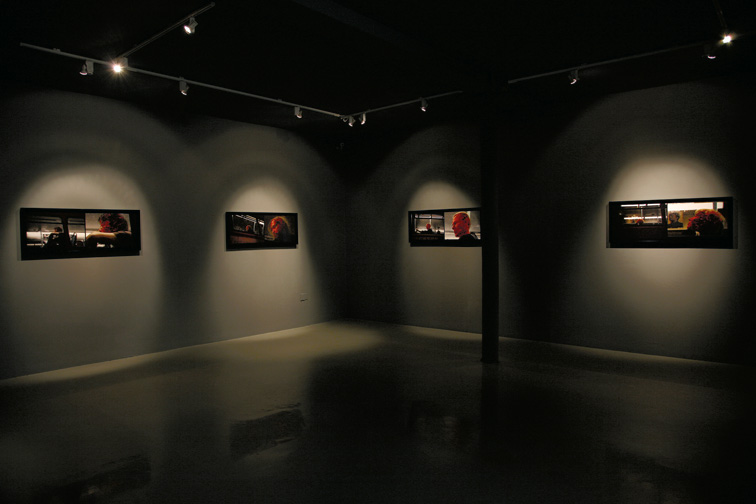
Installation views of work Caul, Dryden Goodwin: Cast, exhibition held at The Photographers’ Gallery, 26 Sept.–16 Nov. 2008. © Dryden Goodwin.
Jason Welling. Courtesy of the Photographers’ Gallery, London.
To give an indication of how long things can take, an exhibition with the UK-based artist Dryden Goodwin took eight years to develop. The conversation began in very early 2000 when Goodwin expressed an interest in exploring the role of photography in his practice. It was not until 2008 that the project happened and was in the end the last exhibition held at the Gallery’s Great Newport Street site. The fact that Goodwin was keen to make new work in and around the Gallery location became a key factor, alongside his own trajectory as an established UK and international artist. The project was in collaboration with the commissioning agency Photoworks. They had secured significant funding to produce a new series of work with Goodwin. They also had a partnership with the international publisher Steidl to develop a monograph alongside the show. The Photographers’ Gallery would not have had the budget to produce a large book and new work without external financial support. Through working together we were also able to find an international touring venue—the Hasselblad centre in Sweden—to take the show after it was seen in London. This was to add income to the project but also offered international profile for the show and the artist. Often, it is the artists who broker such collaborations by mentioning to curators other people and organisations that have expressed interest in their work. Increasingly, with budgets getting smaller, collaborations such as this are becoming more key in curatorial discussions.
Audience
Curators in publicly funded galleries will have a keen sense of who their audiences are and which audiences they are trying to reach. Galleries will have information from marketing departments on the demographic profile of their audiences, which may also indicate the types of shows that may appeal to different groups. This will impact on the work they show and there are trends and fashions within this. A curator may develop a show with a particular audience in mind, for which they could have attained designated funding.
For example, the exhibition Brixton Studio held at The Photographers’ Gallery in 2002, included the archive of a Brixton-based studio portrait photographer Harry Jacobs, alongside a series of new commissioned works by four artists working in Brixton. A local photographer Paul Ellis, saved Jacobs’ work as it was about to be thrown into a skip after he retired. Ellis could see that what he had produced from the 1950s to the 1990s was a rare and valuable community and photography archive. Across the work, the Afro-Caribbean Windrush-year migrants who moved to Brixton from the 1950s were seen, as were their families and future generations. Funding was received to digitise the collection and an artist was employed to work in the community in Brixton to find people who appeared in the photographs and to arrange community-focused events during the show. This was a very specific example of audience-focused programming and reach. More often, such community work will happen through the education programme alongside a show.
In terms of audience, it is not only the general public that a curator will be thinking about, there are a range of other key groups and opinion formers such as the press, funders, patrons and other artists and curators. Getting press coverage for exhibitions can be challenging for venues in London where there is a lot of competition, but equally outside of London it can be difficult simply to get critics to visit shows. A gallery’s press team will have a range of ongoing contacts with reviewers and publishers and this key group will be in their minds when planning and developing a show. The gallery will be in constant contact with funders and individual patrons and donors, and will often hold specific events for those people which artists will be asked to attend. These groups will also strongly impact on how the work and show is positioned and described.
The Language of the Show
The different types of audiences will impact on the language that a curator will use about an exhibition. Often it is one paragraph of 100 to 150 words that will be used repeatedly in marketing material and on websites, in the press release and sent to potential funders. Surprisingly, this can then be literally copied in articles and listings in the papers and online. It will also be used as the basis for interpretative material in the show and on the gallery walls. It will have an institutional, rather than an individual voice and tone. It should use straightforward but informed language, and is likely to be originated by the curator but then go through various internal rounds of editing and input.
It is worth setting your terms with a curator in advance. Are there pieces already written about your work that you particularly like or do you have a way you like your work to be described? Are there terms you would rather avoid, for example the term documentary can be quite contested? Equally, do you want to be called a photographer or an artist? Trusting the curator is part of this process; not only will they be experienced writers and experienced in positioning and describing work, but they will also be the final editors of the text before it goes out into the world.
Outside of this type of writing a curator may also develop a longer piece of text on your work in an essay for a catalogue or online publication. Equally, they may do this for a show they are not working on with you, and most curators will write both for their role and outside of this context. Developing a relationship with them as a writer can be helpful and be a way to nurture a longer-term relationship with them.
Text will also accompany the work itself, the title of the work and the caption for an image. Traditional editorial photography depended on the written word alongside photographs in shows. Often, long captions were needed to contextualise images. Over time the connection between titles and works has shifted and the way that text appears alongside images has also altered. Card-mounted captions are becoming a thing of the past as text is now more often directly adhered to the wall using dry transfer or vinyl lettering. This allows for the use of colour, a play with scale and to experiments with fonts.
Thinking about the Space
In an age when so much photography is consumed online and in books it is worth reflecting on what it might mean to show your work in a gallery space. It is a very different encounter with the work. In preparation for this it is literally well worth living with your work, trying out different print sizes, groupings and sequencing. How many works are needed to convey the meaning of the series? Should all the images be the same size or would it work to make some larger? How might you place them on a wall in a line? As a grid?
Photographers who have studied in fine art schools will often make presentation decisions very early on in their working process. Traditional photographers are unlikely to consider this aspect until much later on in the process. Of course, the type of space you are working with—the height of the walls and the width of the space—will also make a difference to how you might present the work. The gallery space is an installation and a curator from a particular venue will know the space well and should acknowledge both its limitations and strengths. The planning process for a show will often begin with floor plans of the gallery space, which for a new building may be detailed and sophisticated but in an older space are more likely to be basic and rudimentary. However, they are key in the development of the installation and will be used to decide where temporary walls might be built and to estimate how many works will fit into the space. A curator will always pace out such plans in the space with the technical crew and attempt to measure out potential temporary walls. If it is possible to attend these meetings it is well worth it. If that is not possible then detailed conversations and taking advice from the curator will help.
Realistically pre-visualising the space your show will occupy is an important task, but some people find this easier to do than others. It may aid you to work on a scaled plan or you may prefer to be more instinctive. However, turning up two days before a show opens and expecting a complete rebuild of the space will simply not be possible, nor create a good working dynamic. Venues are under immense pressure to be closed for as short a time as possible between exhibitions to prevent a drop in footfall, and the usual loss of income this entails. This means there is usually a specific window to build and install work. Also, for budget management good estimations are needed, especially when working with artists who are overseas. Being clear about the number of works that need to be printed and framed is important, as transport costs are usually very large. Equally, storage space is at a premium in most gallery spaces and the cost of secure offsite storage and insurance can be high.
Ultimately, the exciting time for a curator and artist will be in these tense days whilst work goes up on the wall and the sculptural presence of the show takes shape. Inevitably, things don’t always go to plan, so being responsive to last-minute tweaks can in the end lead to a better realisation of the show. Making it look as good as it can in the space is key, and that requires teamwork with all those at the space, the installation crew and curatorial staff, but often the interns and volunteers as well.
Exhibition Design
Curators and the in-house installation crew face the challenge of having to keep a space looking fresh, by regularly changing its configuration. Thinking of innovative ways to design the space and to brand the show using graphic design and colour is part of enhancing the visitor experience. Audiences are expecting an ever-increasing quality of display that they are used to seeing in museum and gallery spaces internationally. Major museums will employ exhibition designers and can spend a significant amount of their budget on this aspect of a show. Smaller venues have to try and achieve the same effect with less money and using the in-house team.
Spaces can be transformed by simple and cost-effective means and attention to detail. For the Dryden Goodwin installation of the work Caul (see photo), a number of things were done to change the look and feel of the space, including painting all the gallery walls a uniform grey. This changed the lighting level for the show, made what was quite a busy series of spaces feel more coherent and unified, and overall made the space feel much more like a traditional museum. It can take quite a lot of persuasion to get galleries to be willing to paint their white walls a different colour, not least as it takes time after a show to get the walls back to white. But there are times when it can work very well in particular contexts. Sometimes, painting just one wall a different colour can make all the difference.
Presentation of Work
How works are framed and displayed can be one of the biggest costs for a show but will also make a huge difference to the impact of the work on the wall. As with other things there are trends; there was a time when all photographs seemed to be mounted with white card and placed in black-rimmed frames, and other moments when everyone seemed to mount their prints on aluminium with batons on the back that were attached to the wall. Exhibiting work is a chance to try out new print sizes and to play with presentation. Go large and perhaps a frame will not be needed at all and the work can sit pinned on the wall, or if you want to go very big the work might need to be stuck onto the wall—the devil will be in the detail. If you are trying anything new it is well worth factoring in the time to do some tests and trial runs ahead of the show. Again, this is something to discuss with the curator who may have relationships with a particular printer or experience of trying out different sizes in the past.
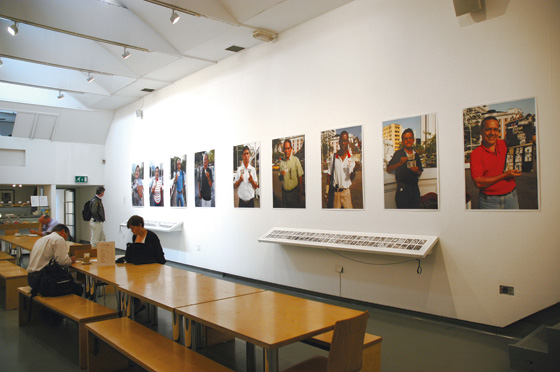
Installation views, Once More with Feeling: Recent Photography from Colombia, exhibition held at The Photographers’ Gallery, 18 April–15 June 2008.
© Oscar Munoz, Mauricio Prieto.
Jason Welling. Courtesy of The Photographers’ Gallery, London.
It is not always necessary or possible for expensive solutions to be found for exhibiting work. With budgets tight often the production costs for a show need to be kept down. With Colombian artist Oscar Munoz’s Archivo porcontacto (2004–2008) this involved developing an installation that needed to combine an archive of small black and white prints with large colour works. On an early site visit we decided to work in a gallery space that was also a café. Several ideas were floated including placing the smaller prints onto the tables in the space with glass on top of them. However, in the end one of the installation crew suggested a simply constructed angled shelf with a plexi-glass insert that could be built in several units along the wall of the space. Above it the large colour prints were simply pinned to the wall. With their white surround and scale this worked well in the space.
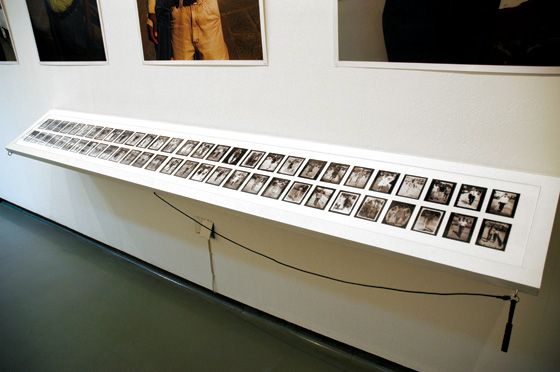
Installation views, Once More with Feeling: Recent Photography from Colombia, exhibition held at the Photographers’ Gallery, 18 April–15 June 2008.
© Oscar Munoz, Mauricio Prieto.
Jason Welling. Courtesy of The Photographers’ Gallery, London.
An increasing trend in contemporary photography is for artists to work with archives of either their own images or with other people’s photographs. Being creative about how these works are installed is a very important part of the work. A good example of this type of practice is the work of Marjolaine Ryley. I have included two examples of shows she has worked on in venues where I have not been involved as a curator, but which demonstrate how different spaces offer alternative ways to exhibit the same work. This series of work Growing up in the New Age comprised a series of colour photographs, some text works and a collection of objects. Two installations are shown here, one at Wolverhampton Art Gallery and the other at Street Level in Glasgow. In Wolverhampton the objects are placed in glass vitrines in the centre of the space. You will see on that on this occasion photographs have been interspersed with text works, which are similarly framed. At Street Level the configuration of works alters as the text work appears on its own in a group and the images are laid out differently. These alterations allow the work to shine in each space and venue but, equally important, provide the viewer with a unique exhibition experience each time the work is shown.
Budgets
A lot of such decisions will inevitably come down to money and a curator will be the gateway between you and the budget. Ultimately their priority is to ensure that the money is spent where the public will see it. It may not seem best value for money to buy one very expensive frame if a series of large prints could be produced for the same budget. Value for money is key but equally artistic integrity and quality is also important. Curators are often adept fundraisers who can work to apply pressure to get more money in at the right time for projects. Equally, when finances are short they will need to find cost-effective yet creative solutions to working with limited funds. Ultimately, they will be responsible for balancing budgets and ensuring they come in on target. So, working with, rather than against them, is key.
During the Show and Beyond
The exhibition will of course be a rare public outing of an artist’s work and will give unique opportunities to get public views on your practice. You will also get some critical assessment of the show. It is well worth listening and documenting this. Taking your own installation shots is a good idea as a venue may do this for their own archives but not in the way that is most helpful for you. Giving talks about your work and meeting the audience can also be very rewarding and helpful. Keeping press cuttings and copies of marketing and printed material is worthwhile for future use in funding applications and as a record of your work. It is worth asking for audience feedback from venues that will most likely over time collate all the print and press material and audience statistics for a show. Often, however, simply spending time in the space—incognito if necessary—and listening to people’s responses can be the best way to gauge reaction to the work.
In conclusion, exhibiting your work should take you as well as the visitor on a journey. It will develop new professional relationships, which may over time lead to other projects and opportunities. It will also introduce an audience to your work and increase your profile as an artist. To develop your reputation you need to have your work shown. Art historians and future generations of researchers and art enthusiasts use these public manifestations as signals of your works significance. Over time they cumulatively lead to museum and collector interest in your work. The creative arts are as much an industry as any other form of business or enterprise, and in some ways exhibiting your work is your way of entering that market. It is time consuming and at times exhausting working on shows but it can equally be enriching and rewarding.
First steps to exhibiting your work may well start with self-initiated projects, group shows, or degree/postgraduate shows. These entry-level opportunities give you valuable experience and insights into how to handle the exhibiting process and what is involved. There are many new ways to develop a public platform for exhibiting work perhaps for an event or at a screening, or through online competitions and websites. However, the social space of the gallery will continue to remain an important arena in which to encounter photography and associated media. There is work and content that is just more fulfilling and meaningful to experience firsthand and to contemplate in a social space with others. What is interesting for a curator is that an exhibition can transform or alter the way a work is seen or understood, which can be a revelation. If you are aspiring to show your work in a gallery context then hopefully this essay will have provided some tips to enable you to start that journey.
